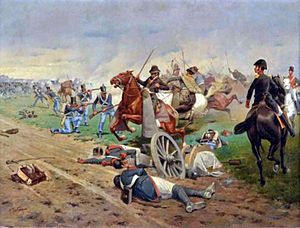Battle of Tucumán
| Battle of Tucumán | |||||||
|---|---|---|---|---|---|---|---|
| Part of Argentine War of Independence | |||||||
 Battle of Tucumán, oil on canvas by Francisco Fortuny |
|||||||
|
|||||||
| Belligerents | |||||||
|
|
|
||||||
| Commanders and leaders | |||||||
|
|
|
||||||
| Strength | |||||||
| 1,800 men | 3,000 men 13 cannons |
||||||
| Casualties and losses | |||||||
| 80 killed 200 wounded |
450 killed 690 prisoners 13 cannons captured |
||||||
|
|
|||||||
The Battle of Tucumán was a battle fought on 24 and 25 September 1812 near the Argentine city of San Miguel de Tucumán, during the Argentine War of Independence. The Army of the North, commanded by General Manuel Belgrano, defeated the royalist troops commanded by General Pío de Tristán, who had a two-to-one advantage in numbers, halting the royalist advance on Argentina's northwest. Together with the Battle of Salta, on 20 February 1813, the victory at Tucumán allowed the Argentine troops to reaffirm the borders under their control.
The Upper Peru region (present-day Bolivia), was again under royalist control after the rebel defeat at Huaqui, where the inexperienced commander Juan José Castelli was easily defeated by the royalist army.
The orders from the First Triumvirate had placed Belgrano in command of the Army of the North on 27 February 1812, headquartered in Jujuy. From there Belgrano attempted to raise the morale of the troops after the defeat at Huaqui. Under that effort on 25 May he raised in Jujuy the new flag he had created a few months back, and had it blessed in Jujuy's Cathedral by Father Juan Ignacio de Gorriti.
He soon realized that he did not have enough strength to defend the city, and on 23 August he ordered a massive retreat of all the civilian population to the interior of Tucumán Province in what was later known as the Éxodo Jujeño. Civilians and military men retreated, destroying anything that could be of value to the royalists. When the Spaniards entered the city, they found it empty:
...
Wikipedia

